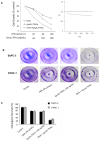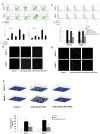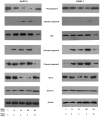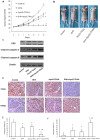Dihydroartemisinin enhances Apo2L/TRAIL-mediated apoptosis in pancreatic cancer cells via ROS-mediated up-regulation of death receptor 5
- PMID: 22666346
- PMCID: PMC3364248
- DOI: 10.1371/journal.pone.0037222
Dihydroartemisinin enhances Apo2L/TRAIL-mediated apoptosis in pancreatic cancer cells via ROS-mediated up-regulation of death receptor 5
Erratum in
- PLoS One. 2012;7(10). doi:10.1371/annotation/f7203563-87dc-4d11-a1b7-958f81cf743a
Abstract
Background: Dihydroartemisinin (DHA), a semi-synthetic derivative of artemisinin, has recently shown antitumor activity in various cancer cells. Apo2 ligand or tumor necrosis factor-related apoptosis-inducing ligand (Apo2L/TRAIL) is regarded as a promising anticancer agent, but chemoresistance affects its efficacy as a treatment strategy. Apoptosis induced by the combination of DHA and Apo2L/TRAIL has not been well documented, and the mechanisms involved remain unclear.
Methodology/principal findings: Here, we report that DHA enhances the efficacy of Apo2L/TRAIL for the treatment of pancreatic cancer. We found that combined therapy using DHA and Apo2L/TRAIL significantly enhanced apoptosis in BxPC-3 and PANC-1 cells compared with single-agent treatment in vitro. The effect of DHA was mediated through the generation of reactive oxygen species, the induction of death receptor 5 (DR5) and the modulation of apoptosis-related proteins. However, N-acetyl cysteine significantly reduced the enhanced apoptosis observed with the combination of DHA and Apo2L/TRAIL. In addition, knockdown of DR5 by small interfering RNA also significantly reduced the amount of apoptosis induced by DHA and Apo2L/TRAIL.
Conclusions/significance: These results suggest that DHA enhances Apo2L/TRAIL-mediated apoptosis in human pancreatic cancer cells through reactive oxygen species-mediated up-regulation of DR5.
Conflict of interest statement
Figures






Similar articles
-
Apigenin sensitizes prostate cancer cells to Apo2L/TRAIL by targeting adenine nucleotide translocase-2.PLoS One. 2013;8(2):e55922. doi: 10.1371/journal.pone.0055922. Epub 2013 Feb 19. PLoS One. 2013. PMID: 23431365 Free PMC article.
-
Cardiac glycosides initiate Apo2L/TRAIL-induced apoptosis in non-small cell lung cancer cells by up-regulation of death receptors 4 and 5.Cancer Res. 2006 Jun 1;66(11):5867-74. doi: 10.1158/0008-5472.CAN-05-3544. Cancer Res. 2006. PMID: 16740726
-
Azadirone, a limonoid tetranortriterpene, induces death receptors and sensitizes human cancer cells to tumor necrosis factor-related apoptosis-inducing ligand (TRAIL) through a p53 protein-independent mechanism: evidence for the role of the ROS-ERK-CHOP-death receptor pathway.J Biol Chem. 2013 Nov 8;288(45):32343-32356. doi: 10.1074/jbc.M113.455188. Epub 2013 Sep 27. J Biol Chem. 2013. PMID: 24078627 Free PMC article.
-
TRAIL receptor signalling and modulation: Are we on the right TRAIL?Cancer Treat Rev. 2009 May;35(3):280-8. doi: 10.1016/j.ctrv.2008.11.006. Epub 2008 Dec 30. Cancer Treat Rev. 2009. PMID: 19117685 Review.
-
Onto better TRAILs for cancer treatment.Cell Death Differ. 2016 May;23(5):733-47. doi: 10.1038/cdd.2015.174. Epub 2016 Mar 4. Cell Death Differ. 2016. PMID: 26943322 Free PMC article. Review.
Cited by
-
Artemisinin Derivatives Stimulate DR5-Specific TRAIL-Induced Apoptosis by Regulating Wildtype P53.Cancers (Basel). 2020 Sep 4;12(9):2514. doi: 10.3390/cancers12092514. Cancers (Basel). 2020. PMID: 32899699 Free PMC article.
-
Resistance to Gemcitabine in Pancreatic Ductal Adenocarcinoma: A Physiopathologic and Pharmacologic Review.Cancers (Basel). 2022 May 18;14(10):2486. doi: 10.3390/cancers14102486. Cancers (Basel). 2022. PMID: 35626089 Free PMC article. Review.
-
Artemisinin inhibits gastric cancer cell proliferation through upregulation of p53.Tumour Biol. 2014 Feb;35(2):1403-9. doi: 10.1007/s13277-013-1193-1. Tumour Biol. 2014. PMID: 24078446
-
Anticancer properties of distinct antimalarial drug classes.PLoS One. 2013 Dec 31;8(12):e82962. doi: 10.1371/journal.pone.0082962. eCollection 2013. PLoS One. 2013. PMID: 24391728 Free PMC article.
-
Restoring TRAIL Induced Apoptosis Using Naturopathy. Hercules Joins Hand with Nature to Triumph Over Lernaean Hydra.Curr Genomics. 2017 Feb;18(1):27-38. doi: 10.2174/1389202917666160803150023. Curr Genomics. 2017. PMID: 28503088 Free PMC article. Review.
References
-
- Raraty MG, Magee CJ, Ghaneh P, Neoptolemos JP. New techniques and agents in the adjuvant therapy of pancreatic cancer. Acta Oncol. 2002;41:582–595. - PubMed
-
- Beger HG, Rau B, Gansauge F, Poch B, Link KH. Treatment of pancreatic cancer: Challenge of the facts. World J Surg. 2003;27:1075–1084. - PubMed
-
- Jemal A, Siegel R, Ward E, Hao Y, Xu J, et al. Cancer statistics, 2008. CA Cancer J Clin. 2008;58:71–96. - PubMed
-
- Meshnick SR. Artemisinin: mechanisms of action, resistance and toxicity. Int J Parasitol. 2002;32:1655–1660. - PubMed
-
- O'Neill PM, Posner GH. A medicinal chemistry perspective on artemisinin and related endoperoxides. J Med Chem. 2004;47:2945–2964. - PubMed
Publication types
MeSH terms
Substances
LinkOut - more resources
Full Text Sources
Other Literature Sources
Medical

